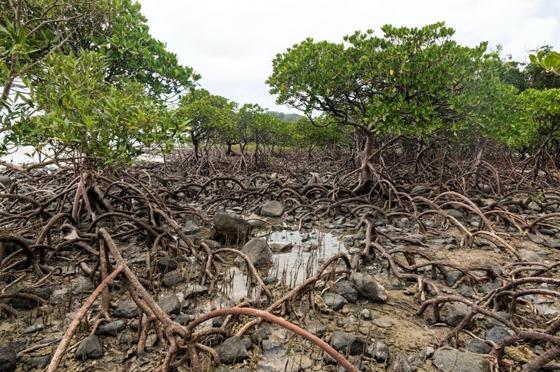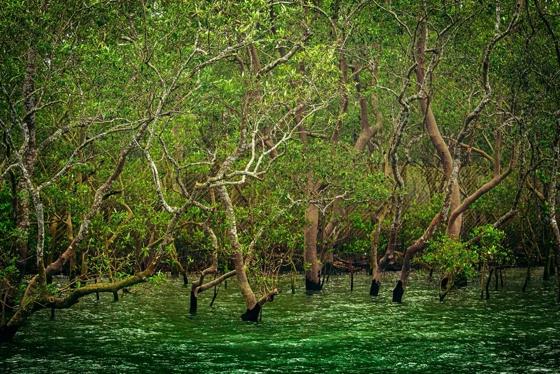Mangrove Forest: An Educational Game Adventure
This blogpost describes a third example developed by the students of the University of Turin (Course on the Agenda 2030, coordinated by Margherita Poto at the Department of Management) on the connection between land and sea. They developed a prototype of a board game that makes us reflect on connectivity in nature. Enjoy the reading and try to play it with your friends!
Mangrove Forest: An Educational Game Adventure
By: Banafsheh Hezardastan
A project developed by Chiara Catanzaro, Parisa Chehrehvar, Banafsheh Hezardastan, Elisa Jani, Leonardo Jovanovski, Carola Riva, Virginia Romano, Majdi Tiba, Mobina Zakerinejad
In early March, our team was given the task of researching the connection between SDG 14 and SDG 15. We manage this task, particularly focusing on the significance of mangrove forests in achieving these goals. We knew that simply presenting our research findings in a typical report format wouldn't engage our audience. We wanted to create something unique that would not only showcase our knowledge but would also inspire others to take action toward the SDGs. During our brainstorming session, we realized that a game could be the perfect medium to communicate the importance of mangrove forests and their connection to the SDGs. Games are interactive and can appeal to a wide range of ages and interests.
Thus, we embarked on creating a game based on mangrove forests and the SDGs. The game called “Mangrowes” stresses how important it is to stick together to make mangroves grow again. It was a long process that involved researching and defining the game's mechanics, graphics, and storyline. We wanted the game to be informative, educational, and entertaining. We wanted players to learn about the importance of mangrove forests and their role in supporting marine life while also promoting the SDGs.

The board game
Our game takes players on a virtual tour of a mangrove forest, where they can interact with various marine creatures and learn about the different aspects of the SDGs. Players have to complete various challenges that are linked to the SDGs.

Scan the code to start the game!
But the Importance of Mangrove Forests: Why We Need to Protect Them?
Let's talk about mangrove forests. These unique and valuable ecosystems are found in tropical and subtropical coastal areas around the world. Mangroves are characterised by a complex mix of trees and shrubs that are adapted to grow in saline and brackish water conditions, with intricate root systems that stabilise often-muddy and unstable coastal soils.

Copyright free picture of mangrove trees
Mangrove forests provide habitat for a wide variety of plant and animal species, some of which are found nowhere else on Earth, including many endangered and threatened species such as the mangrove horseshoe crab and the saltwater crocodile. These forests are also important for the livelihoods of coastal communities, providing goods such as timber, fish, and medicinal plants, as well as ecosystem services such as carbon sequestration and coastal protection.

Copyright free picture showing the connectivity between mangroves and water
However, mangrove forests are under threat from various human activities, including deforestation, land conversion, pollution, and climate change. The conservation and sustainable use of mangrove forests are critical to maintaining the health and resilience of these ecosystems and the communities that depend on them.
Efforts to protect and restore mangrove forests have focused on a range of strategies, including community-based management, payment for ecosystem services, and policy reform. The conservation and sustainable management of mangrove forests represent an important and complex challenge for global conservation and development efforts. Addressing this challenge will require continued research, policy innovation, and collaboration among diverse stakeholders at multiple scales.
The final word:
Mangrove forests are essential ecosystems that provide a wide range of ecological, social, and economic benefits. The conservation and sustainable use of mangrove forests are critical to maintaining the health and resilience of these ecosystems and the communities that depend on them. The challenges are significant, but the benefits of successful mangrove conservation and sustainable use efforts are considerable, including the preservation of biodiversity, the protection of coastal communities from natural disasters, and the promotion of sustainable livelihoods.

Another copyright free picture of beautiful mangroves in water
So next time you're feeling bogged down by the stresses of life, remember the resilience of the mighty mangroves and let them inspire you to keep pushing through.
***
This post may be cited as: Banafsheh Hezardastan, Mangrove Forest: An Educational Game Adventure, A project developed by Chiara Catanzaro, Parisa Chehrehvar, Banafsheh Hezardastan, Elisa Jani, Leonardo Jovanovski, Carola Riva, Virginia Romano, Majdi Tiba, Mobina Zakerinejad, April 9, 2023, online: here